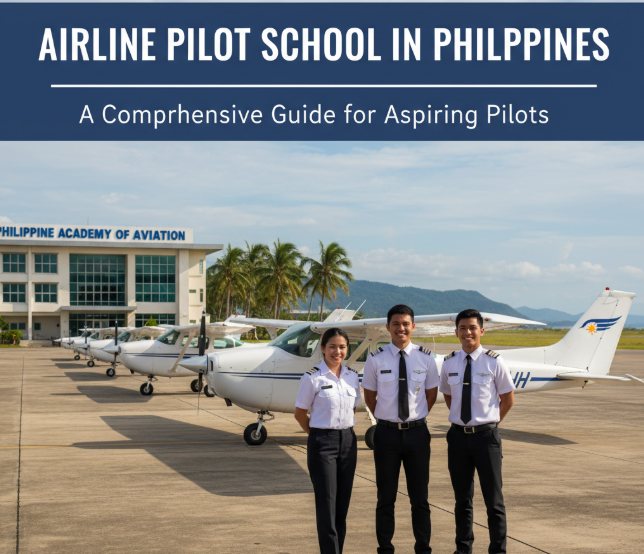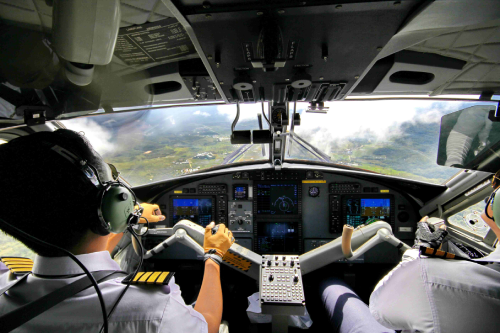
Introduction to Airline Pilot School in Philippines
Becoming an airline pilot is a dream for many, but it requires extensive training, dedication, and the right education. In the Philippines, aspiring pilots have access to world-class pilot schools and aviation institutes that equip them with the necessary skills and qualifications to succeed in the aviation industry. This comprehensive guide provides a deep dive into the airline pilot school system in the Philippines, highlighting the importance of aviation in the country, eligibility requirements, training programs, the challenges faced by pilot trainees, and the future of aviation in the Philippines.
What Is an Airline Pilot School?
An airline pilot school (or pilot training academy) is an institution dedicated to teaching individuals the skills and knowledge required to operate aircraft safely and efficiently. These schools provide a combination of theoretical education and hands-on flight training, which culminates in obtaining a pilot’s license. The goal of these schools is to produce skilled and qualified pilots capable of handling both commercial flights and private aviation.
In the Philippines, pilot schools and aviation academies offer a variety of programs tailored to different stages of a pilot’s career. From foundational Private Pilot License (PPL) training to more advanced programs like Commercial Pilot License (CPL) and Airline Transport Pilot License (ATPL), these institutions serve as the starting point for a successful aviation career.
Importance of Aviation in the Philippines
The Philippines is a rapidly developing aviation hub in Southeast Asia. With over 7,000 islands, the country has a strong reliance on air travel to connect its various regions. Moreover, the Philippine Airlines (PAL) and several other local carriers serve as crucial players in the country’s transportation infrastructure. The Civil Aviation Authority of the Philippines (CAAP) ensures that the aviation sector remains regulated and operates according to international standards, promoting the industry’s growth.
In addition to local air travel, the Philippines serves as a growing international aviation destination, with numerous international flights connecting the country to the rest of the world. As air travel continues to expand, so does the demand for skilled pilots, making pilot training in the Philippines a valuable investment for individuals seeking global aviation careers.
History and Development of Aviation in the Philippines
Early Aviation History of the Philippines
The aviation industry in the Philippines has a rich history that dates back to the early 20th century. The first aircraft in the Philippines, a Curtiss JN-4, was brought to the country in 1911 by an American aviator, signaling the dawn of aviation in the region. In the years that followed, the Philippines saw the establishment of its first commercial airline, Philippine Airlines (PAL), in 1941.
Milestones in Philippine Aviation
Throughout the years, the Philippines has achieved several key milestones in its aviation development. These include:
- 1941: Philippine Airlines (PAL) was established, becoming the first commercial airline in Asia.
- 1970s: The Philippines joined the International Civil Aviation Organization (ICAO), adhering to global standards for aviation safety.
- 1990s: The development of modern airports such as Ninoy Aquino International Airport (NAIA) paved the way for international aviation growth.
In recent decades, the rise of budget airlines like Cebu Pacific and AirAsia Philippines has made air travel more affordable and accessible, expanding the demand for aviation professionals.
Current Role of Airline Pilot Schools in the Philippines
Today, airline pilot schools in the Philippines play a vital role in ensuring that the country’s aviation industry has a steady supply of qualified pilots. These institutions provide:
- High-quality flight training: Utilizing advanced simulators and modern aircraft to ensure a safe learning environment.
- Licensing and certifications: Offering training programs for different pilot certifications, including PPL, CPL, and ATPL.
- International recognition: Many Philippine-based pilot schools are internationally recognized, making their graduates eligible for jobs with airlines around the world.
These schools are not just preparing students for commercial airline jobs, but also for other sectors like private aviation, military aviation, and space exploration as global aviation and technology evolve.
Eligibility, Training, and Skills Required
Basic Qualifications for Pilot Training in Philippines
Before enrolling in an airline pilot school, aspiring pilots must meet certain basic qualifications, which generally include:
- Minimum age: Typically, students must be at least 17 years old for PPL and 18 years old for CPL.
- Educational requirements: A high school diploma is the basic requirement, though many pilot schools prefer students who have completed a college degree in aviation, engineering, or related fields.
- Health standards: Applicants must pass a Class 1 Medical Certificate from a licensed aviation medical examiner, ensuring they are fit to fly.
- English proficiency: English is the international language of aviation, so students must have a good grasp of the language, both written and spoken.
Technical & Soft Skills Required
Aviation training is demanding, and students must develop a diverse skill set, including:
- Technical knowledge: Familiarity with aircraft systems, navigation techniques, meteorology, air traffic control, and aviation regulations.
- Soft skills: Leadership, communication, decision-making, and problem-solving abilities are critical for pilots, as they must remain calm and effective in high-pressure situations.
Institutes, Academies, and Training Centers in Philippines
The Philippines is home to several reputable flight schools and aviation institutes. Some of the top institutions include:
- Philippine Airline Pilot School (PAPS): One of the oldest and most recognized pilot schools in the Philippines.
- AeroTech Training Center: Known for its comprehensive training programs, including aircraft maintenance and flight training.
- Mactan Aviation Academy: Offers a variety of courses, from PPL to ATPL, and focuses on hands-on flight training.
- University of the Philippines Aviation School: Offers degree programs in aviation and provides a strong theoretical foundation for aspiring pilots.
- Cebu Pacific Pilot Academy: Affiliated with Cebu Pacific, this academy provides an excellent pathway for pilots wishing to join the airline.
These institutes collaborate with global agencies and regulatory bodies like the ICAO, FAA, and EASA to ensure that their training programs meet international aviation standards.
Government Initiatives
The Civil Aviation Authority of the Philippines (CAAP) is responsible for regulating aviation training standards, ensuring that Philippine flight schools comply with both local and international regulations. In addition, various government initiatives, such as partnerships with international agencies, have helped elevate the country’s aviation education standards.
Technology and Innovation in Aviation Training
The Role of Flight Simulators
Flight simulators are an integral part of pilot training, allowing students to practice flying without leaving the ground. These advanced simulators replicate real-life flying conditions, helping students master flight maneuvers, navigation, and emergency procedures in a safe environment.
The Future of AI in Aviation
The integration of artificial intelligence (AI) and machine learning in aviation training is reshaping the industry. AI can be used to improve flight simulation, optimize cockpit design, and enhance safety protocols. Some Philippine aviation schools are already incorporating AI-driven tools to improve training efficiency.
Space Exploration and Pilot Training
As space tourism and private aviation expand, future pilots may need to be trained for space travel. While this may seem futuristic, many aviation institutions in the Philippines are staying ahead of the curve by incorporating space navigation and digital cockpit training into their curricula.
Challenges Faced in Pilot Training in the Philippines
While the aviation industry in the Philippines is growing, there are several challenges facing pilot training programs:
- Infrastructure gaps: Some pilot schools struggle with outdated aircraft and training equipment, affecting the quality of training.
- High costs: Training to become a pilot can be expensive, and not all students can afford the fees.
- Regulatory hurdles: Pilots must navigate a complex system of international and national regulations, which can make training more challenging.
Brain Drain: Losing Trained Pilots to Foreign Airlines
Despite the world-class training offered by Philippine aviation schools, many pilots choose to work abroad, particularly in the Middle East and the United States, where salaries are higher. This brain drain poses a challenge for the country’s aviation industry.
The Future of Airline Pilot School in Philippines
The future of airline pilot schools in the Philippines is bright, with advancements in technology and increasing demand for pilots. Key trends shaping the future include:
- Space tourism: With the rise of companies like Blue Origin and SpaceX, aspiring pilots may eventually have the opportunity to train for space flights.
- Private aviation: As the global middle class grows, private aviation is becoming more accessible, increasing the demand for private pilots.
- AI in training: Artificial intelligence and machine learning will continue to enhance the training experience, creating more effective and immersive training programs.
Career Path & Opportunities
Step-by-Step Guide to Becoming a Pilot
- Education: Complete high school or a college degree in aviation.
- Pilot Training: Enroll in a reputable pilot school to obtain your PPL, CPL, and ATPL.
- Flight Hours: Accumulate required flight hours.
- Certification: Obtain your pilot’s license from the Civil Aviation Authority of the Philippines (CAAP).
- Advanced Training: Pursue further certifications (e.g., flight instructor, space aviation).
Salary Expectations and Global Scope
In the Philippines, the average salary for commercial pilots is around PHP 500,000 per month, but it can vary based on experience and the airline. For those pursuing international careers, salaries can be significantly higher, with pilots working for foreign airlines often earning several times more.
FAQs (10–12 Q&A)
- How much does pilot training cost in the Philippines?
- The cost of pilot training in the Philippines can range from PHP 1.5 million to PHP 2.5 million, depending on the institution and type of program.
- Which is the best aviation institute in the Philippines?
- Some of the top aviation institutes include Philippine Airline Pilot School (PAPS) and AeroTech Training Center.
- What qualifications are needed for pilot training in the Philippines?
- Students must have a high school diploma, pass a medical exam, and meet age requirements.
- Is international flight training available in the Philippines?
- Yes, several Philippine flight schools offer internationally recognized training programs.
- What is the future of aviation in the Philippines?
- The future of aviation in the Philippines looks promising with increasing demand for pilots, especially with the rise of space tourism and private aviation.
Conclusion / Final Thoughts
Aviation in the Philippines is thriving, and aspiring pilots have a wealth of opportunities available. With world-class flight schools, advanced training programs, and strong government support, the Philippines remains a top destination for pilot training. Whether you’re pursuing a career in commercial aviation or aiming for a more adventurous role in space exploration, the path to becoming a pilot in the Philippines is full of exciting possibilities.
SEO Keywords:
- Airline Pilot School in Philippines
- Pilot training in Philippines
- Aviation careers in Philippines
- Flight school in Philippines
- Airline pilot program in Philippines
- International flight training in Philippines
- Philippines pilot academy
- Pilot courses in Philippines
- Philippines aviation institute
- Airline pilot training in Philippines
- Flight instructor in Philippines
- Future of aviation in Philippines
![Image: Students inside a flight simulator in Philippines]
![Image: Modern pilot training aircraft in Philippines]
